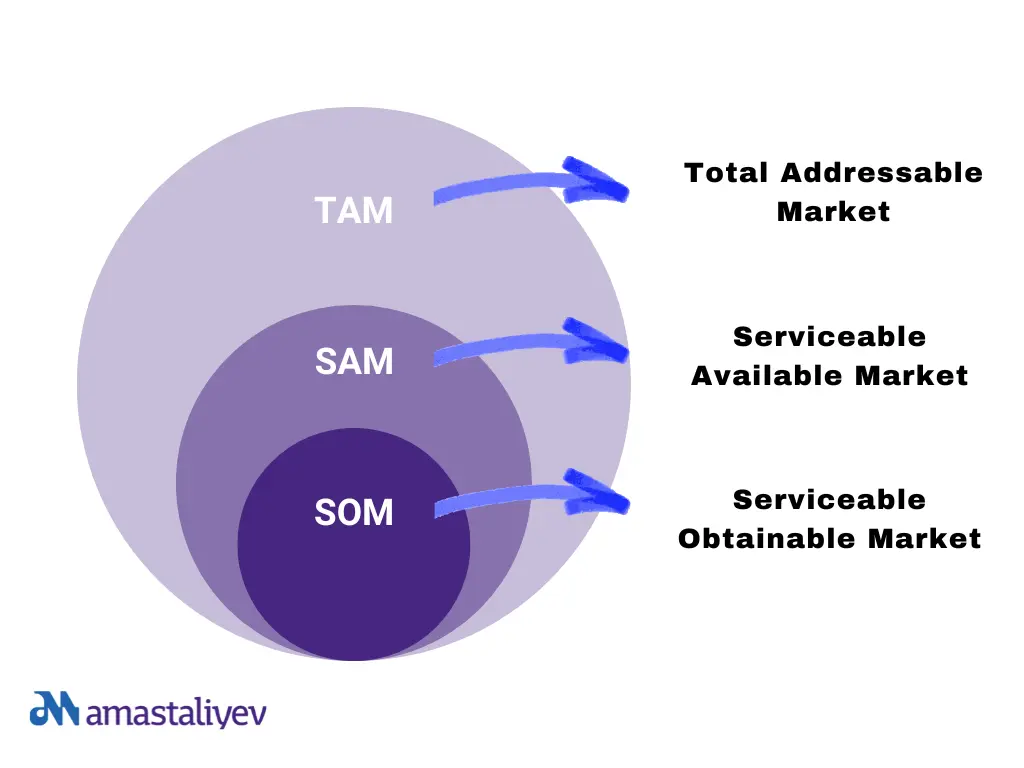Understanding the market potential for a new business or product line is a critical step for entrepreneurs and investors alike. The concepts of Total Addressable Market (TAM), Serviceable Available Market (SAM), and Serviceable Obtainable Market (SOM) serve as key metrics to gauge this potential. These metrics not only illuminate the size and accessibility of a market but also help in strategizing business growth and securing investments.
Deciphering TAM, SAM, and SOM
TAM (Total Addressable Market): This is the widest possible market that could possibly purchase a product or service. It represents an ideal scenario without considering market constraints like geography, demographics, or competitive presence. For instance, the TAM for a digital marketing tool could encompass all online businesses globally.
SAM (Serviceable Available Market): SAM narrows down from TAM to focus on the segment that is actually accessible to a business, considering current limitations such as geographical reach and product relevance. In the digital marketing tool example, SAM might only include online businesses in English-speaking countries, aligning with the tool’s language capabilities.
SOM (Serviceable Obtainable Market): The most targeted metric, SOM, delves into the portion of SAM that a business can realistically capture, considering the competitive landscape and market share. SOM is crucial for setting realistic short-term business objectives and is a key indicator of potential growth.
The Strategic Importance of TAM, SAM, and SOM
These metrics are not just numbers; they guide critical business decisions:
- Market Entry and Expansion: Understanding TAM can reveal the long-term potential for market expansion, while SAM and SOM provide insights into immediate opportunities and realistic targets.
- Investor Engagement: For startups seeking funding, articulating the TAM, SAM, and SOM can significantly enhance investment pitches by demonstrating the business growth potential and realistic market capture strategies.
- Resource Allocation: By identifying the most accessible and winnable market segments (SOM), businesses can more efficiently allocate marketing and operational resources.
Calculating Market Potential
The calculation of TAM, SAM, and SOM involves both top-down and bottom-up analysis, requiring thorough market research. For TAM, it’s about identifying the broadest potential customer base. SAM calculations refine this number by focusing on the segments your business model can actually serve. SOM then requires a more nuanced analysis, considering your competitive advantage, pricing strategy, and distribution channels to estimate the market share you can realistically achieve.
Putting TAM, SAM, and SOM into Practice: A Calculation Example
Scenario: Imagine a tech startup, CloudSafe, offering innovative cloud storage solutions specifically designed for small to medium-sized businesses (SMBs) in the United States.
Total Addressable Market (TAM)
Objective: Estimate the broadest potential market for cloud storage solutions.
Calculation:
- There are approximately 30 million SMBs in the United States.
- Assuming each SMB could spend an average of $1,200 per year on cloud storage solutions, the TAM can be calculated as:
TAM=30,000,000 SMBs×$1,200 / SMB / year
TAM=$36billion/ year
This figure represents the total potential annual market for cloud storage solutions targeting SMBs in the United States, without considering any limitations.
Serviceable Available Market (SAM)
Objective: Focus on the segment of the TAM that CloudSafe can realistically target given its product offering and current limitations.
Calculation:
- If CloudSafe’s solution is tailored for businesses with 10 to 200 employees, and research shows that this represents about 40% of all SMBs in the United States, then SAM can be calculated as:
SAM=40%×$36billion
SAM=$14.4billion/ year
This narrowed focus helps CloudSafe understand the portion of the market it can actually serve with its current business model and product features.
Serviceable Obtainable Market (SOM)
Objective: Determine the portion of the SAM that CloudSafe can realistically capture in the next 3-5 years, considering competition and market penetration strategies.
Calculation:
- Assuming CloudSafe aims to capture 5% of its SAM within the first 3-5 years through aggressive marketing and partnerships, the SOM would be:
SOM=5%×$14.4billion
SOM=$720million/ year
This figure represents CloudSafe’s short-term revenue potential within its serviceable market, providing a realistic goal for the startup to aim for.
Maximizing Market Capture
Strategies to maximize your SOM and effectively penetrate your SAM include:
- Defining Your Unique Selling Proposition (USP): Clearly articulating what sets your product or service apart can help capture a larger share of the market.
- Competitive Pricing Strategies: Understanding the pricing landscape can enable you to position your offering more attractively.
- Enhancing Customer Experience: Prioritizing customer service and personalization can lead to higher customer retention and market share.
Practical Applications: From Plans to Action
Incorporating TAM, SAM, and SOM into your business plan transforms abstract market potential into actionable strategies. These metrics provide a structured framework to assess growth opportunities, prioritize business initiatives, and articulate the value proposition to stakeholders.
- Business Planning: Embedding TAM, SAM, and SOM in your business plan demonstrates a deep understanding of the market potential and operational focus areas.
- Investor Presentations: Highlighting these metrics in investor discussions can bolster confidence in the business’s targeted growth strategy and potential for success.
Conclusion
TAM, SAM, and SOM are indispensable tools for businesses at any stage. They not only help in assessing the overall market potential but also in crafting focused strategies for market penetration and growth. By effectively calculating and leveraging these metrics, businesses can navigate the complexities of market dynamics, align their resources efficiently, and build a compelling case for investment. Remember, a thorough understanding of your market’s size and your place within it is crucial for sustained success and scalability.

